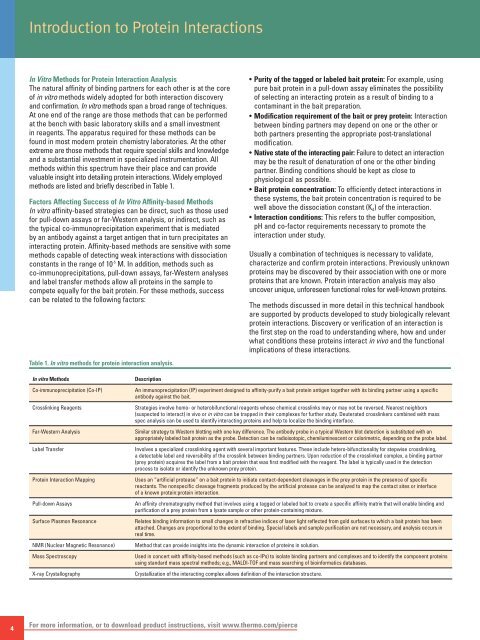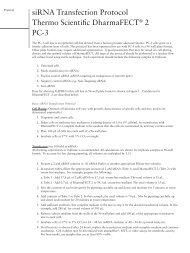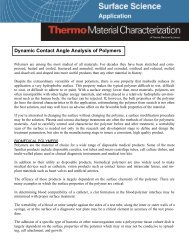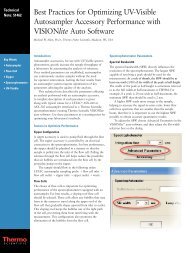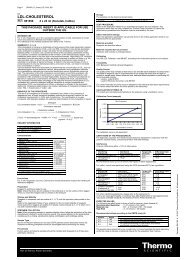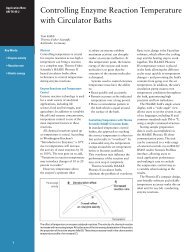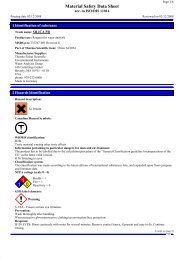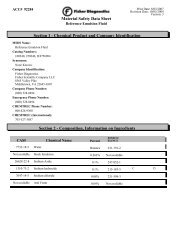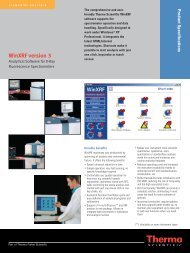Thermo Scientific Pierce Protein Interaction Technical Handbook
Thermo Scientific Pierce Protein Interaction Technical Handbook
Thermo Scientific Pierce Protein Interaction Technical Handbook
You also want an ePaper? Increase the reach of your titles
YUMPU automatically turns print PDFs into web optimized ePapers that Google loves.
Introduction to <strong>Protein</strong> <strong>Interaction</strong>s<br />
In Vitro Methods for <strong>Protein</strong> <strong>Interaction</strong> Analysis<br />
The natural affinity of binding partners for each other is at the core<br />
of in vitro methods widely adopted for both interaction discovery<br />
and confirmation. In vitro methods span a broad range of techniques.<br />
At one end of the range are those methods that can be performed<br />
at the bench with basic laboratory skills and a small investment<br />
in reagents. The apparatus required for these methods can be<br />
found in most modern protein chemistry laboratories. At the other<br />
extreme are those methods that require special skills and knowledge<br />
and a substantial investment in specialized instrumentation. All<br />
methods within this spectrum have their place and can provide<br />
valuable insight into detailing protein interactions. Widely employed<br />
methods are listed and briefly described in Table 1.<br />
Factors Affecting Success of In Vitro Affinity-based Methods<br />
In vitro affinity-based strategies can be direct, such as those used<br />
for pull-down assays or far-Western analysis, or indirect, such as<br />
the typical co-immunoprecipitation experiment that is mediated<br />
by an antibody against a target antigen that in turn precipitates an<br />
interacting protein. Affinity-based methods are sensitive with some<br />
methods capable of detecting weak interactions with dissociation<br />
constants in the range of 10 -5 M. In addition, methods such as<br />
co-immunoprecipitations, pull-down assays, far-Western analyses<br />
and label transfer methods allow all proteins in the sample to<br />
compete equally for the bait protein. For these methods, success<br />
can be related to the following factors:<br />
Table 1. In vitro methods for protein interaction analysis.<br />
• Purity of the tagged or labeled bait protein: For example, using<br />
pure bait protein in a pull-down assay eliminates the possibility<br />
of selecting an interacting protein as a result of binding to a<br />
contaminant in the bait preparation.<br />
• Modification requirement of the bait or prey protein: <strong>Interaction</strong><br />
between binding partners may depend on one or the other or<br />
both partners presenting the appropriate post-translational<br />
modification.<br />
• Native state of the interacting pair: Failure to detect an interaction<br />
may be the result of denaturation of one or the other binding<br />
partner. Binding conditions should be kept as close to<br />
physiological as possible.<br />
• Bait protein concentration: To efficiently detect interactions in<br />
these systems, the bait protein concentration is required to be<br />
well above the dissociation constant (K d ) of the interaction.<br />
• <strong>Interaction</strong> conditions: This refers to the buffer composition,<br />
pH and co-factor requirements necessary to promote the<br />
interaction under study.<br />
Usually a combination of techniques is necessary to validate,<br />
characterize and confirm protein interactions. Previously unknown<br />
proteins may be discovered by their association with one or more<br />
proteins that are known. <strong>Protein</strong> interaction analysis may also<br />
uncover unique, unforeseen functional roles for well-known proteins.<br />
The methods discussed in more detail in this technical handbook<br />
are supported by products developed to study biologically relevant<br />
protein interactions. Discovery or verification of an interaction is<br />
the first step on the road to understanding where, how and under<br />
what conditions these proteins interact in vivo and the functional<br />
implications of these interactions.<br />
In vitro Methods<br />
Co-immunoprecipitation (Co-IP)<br />
Crosslinking Reagents<br />
Far-Western Analysis<br />
Label Transfer<br />
<strong>Protein</strong> <strong>Interaction</strong> Mapping<br />
Pull-down Assays<br />
Surface Plasmon Resonance<br />
NMR (Nuclear Magnetic Resonance)<br />
Mass Spectroscopy<br />
X-ray Crystallography<br />
Description<br />
An immunoprecipitation (IP) experiment designed to affinity-purify a bait protein antigen together with its binding partner using a specific<br />
antibody against the bait.<br />
Strategies involve homo- or heterobifunctional reagents whose chemical crosslinks may or may not be reversed. Nearest neighbors<br />
(suspected to interact) in vivo or in vitro can be trapped in their complexes for further study. Deuterated crosslinkers combined with mass<br />
spec analysis can be used to identify interacting proteins and help to localize the binding interface.<br />
Similar strategy to Western blotting with one key difference. The antibody probe in a typical Western blot detection is substituted with an<br />
appropriately labeled bait protein as the probe. Detection can be radioisotopic, chemiluminescent or colorimetric, depending on the probe label.<br />
Involves a specialized crosslinking agent with several important features. These include hetero-bifunctionality for stepwise crosslinking,<br />
a detectable label and reversibility of the crosslink between binding partners. Upon reduction of the crosslinked complex, a binding partner<br />
(prey protein) acquires the label from a bait protein that was first modified with the reagent. The label is typically used in the detection<br />
process to isolate or identify the unknown prey protein.<br />
Uses an “artificial protease” on a bait protein to initiate contact-dependent cleavages in the prey protein in the presence of specific<br />
reactants. The nonspecific cleavage fragments produced by the artificial protease can be analyzed to map the contact sites or interface<br />
of a known protein:protein interaction.<br />
An affinity chromatography method that involves using a tagged or labeled bait to create a specific affinity matrix that will enable binding and<br />
purification of a prey protein from a lysate sample or other protein-containing mixture.<br />
Relates binding information to small changes in refractive indices of laser light reflected from gold surfaces to which a bait protein has been<br />
attached. Changes are proportional to the extent of binding. Special labels and sample purification are not necessary, and analysis occurs in<br />
real time.<br />
Method that can provide insights into the dynamic interaction of proteins in solution.<br />
Used in concert with affinity-based methods (such as co-IPs) to isolate binding partners and complexes and to identify the component proteins<br />
using standard mass spectral methods; e.g., MALDI-TOF and mass searching of bioinformatics databases.<br />
Crystallization of the interacting complex allows definition of the interaction structure.<br />
4<br />
For more information, or to download product instructions, visit www.thermo.com/pierce


